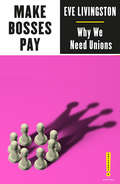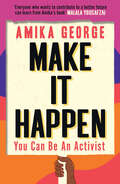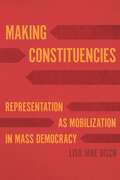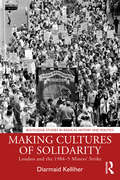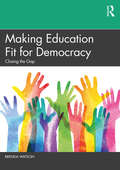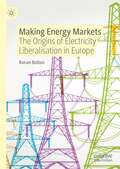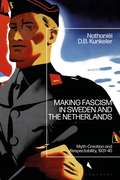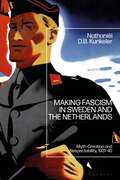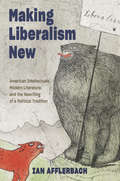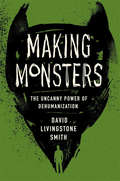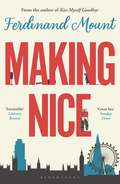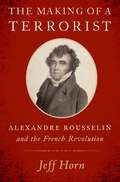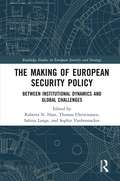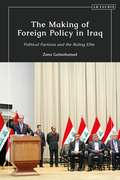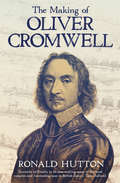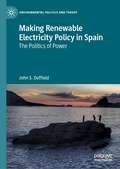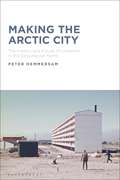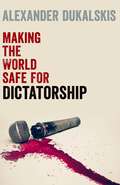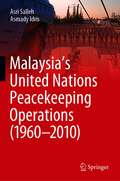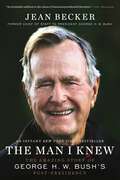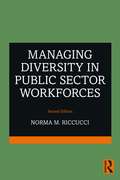- Table View
- List View
Make Bosses Pay: Why We Need Unions (Outspoken by Pluto)
by Eve LivingstonWith the world changing at breakneck speed and workers at the whim of apps, bad bosses and zero-hours contracts, why should we care about unions? Aren’t they just for white-haired, middle-aged miners anyway? The government constantly attacks unions, CEOs devote endless time and resources to undermining them, and many unions themselves are stuck in the past. Despite this, inspiring work is happening all the time, from fast food strikes and climate change campaigning to the modernisation of unions for the digital age. Speaking to academics, experts and grassroots organisers from TUC, UNISON, ACORN, IWGB and more, Eve Livingston explores how young workers are organising to demand fair workplaces, and reimagines what an inclusive union movement that represents us all might look like. Working together can change the course of history, and our bosses know that. Yes, you need a union, but your union also needs you!
Make it Happen: How To Be An Activist
by Amika George‘Make It Happen reminds us that people of any age can create change in their communities. From finding allies to setting goals, everyone who wants to contribute to a better future can learn from Amika's book.’ Malala Yousafzai
Making Constituencies: Representation as Mobilization in Mass Democracy
by Lisa Jane DischPublic division is not new; in fact, it is the lifeblood of politics, and political representatives have constructed divisions throughout history to mobilize constituencies. Since the turn of the twenty-first century, the idea of a divided United States has become commonplace. In the wake of the 2020 election, some commentators warned that the American public was the most divided it has been since the Civil War. Political scientists, political theorists, and public intellectuals have suggested that uninformed, misinformed, and disinformed voters are at the root of this division. Some are simply unwilling to accept facts or science, which makes them easy targets for elite manipulation. It also creates a grass-roots political culture that discourages cross-partisan collaboration in Washington. Yet, manipulation of voters is not as grave a threat to democracy in America as many scholars and pundits make it out to be. The greater threat comes from a picture that partisans use to rally their supporters: that of an America sorted into opposing camps so deeply rooted that they cannot be shaken loose and remade. Making Constituencies proposes a new theory of representation as mobilization to argue that divisions like these are not inherent in society, but created, and political representatives of all kinds forge and deploy them to cultivate constituencies.
Making Constituencies: Representation as Mobilization in Mass Democracy
by Lisa Jane DischPublic division is not new; in fact, it is the lifeblood of politics, and political representatives have constructed divisions throughout history to mobilize constituencies. Since the turn of the twenty-first century, the idea of a divided United States has become commonplace. In the wake of the 2020 election, some commentators warned that the American public was the most divided it has been since the Civil War. Political scientists, political theorists, and public intellectuals have suggested that uninformed, misinformed, and disinformed voters are at the root of this division. Some are simply unwilling to accept facts or science, which makes them easy targets for elite manipulation. It also creates a grass-roots political culture that discourages cross-partisan collaboration in Washington. Yet, manipulation of voters is not as grave a threat to democracy in America as many scholars and pundits make it out to be. The greater threat comes from a picture that partisans use to rally their supporters: that of an America sorted into opposing camps so deeply rooted that they cannot be shaken loose and remade. Making Constituencies proposes a new theory of representation as mobilization to argue that divisions like these are not inherent in society, but created, and political representatives of all kinds forge and deploy them to cultivate constituencies.
Making Cultures of Solidarity: London and the 1984–5 Miners’ Strike (Routledge Studies in Radical History and Politics)
by Diarmaid KelliherThis book combines radical history, critical geography, and political theory in an innovative history of the solidarity campaign in London during the 1984-5 miners’ strike. Thousands of people collected food and money, joined picket lines and demonstrations, organised meetings, travelled to mining areas, and hosted coalfield activists in their homes during the strike. The support campaign encompassed longstanding elements of the British labour movement as well as autonomously organised Black, lesbian and gay, and feminist support groups. This book shows how the solidarity of 1984-5 was rooted in the development of mutual relationships of support between the coalfields and the capital since the late 1960s. It argues that a culture of solidarity was developed through industrial and political struggles that brought together diverse activists from mining communities and London. The book also takes the story forward, exploring the aftermath of the miners’ strike and the complex legacies of the support movement up to the present day. This rich history provides a compelling example of how solidarity can cross geographical and social boundaries. This book is essential reading for students, scholars, and activists with an interest in left-wing politics and history.
Making Cultures of Solidarity: London and the 1984–5 Miners’ Strike (Routledge Studies in Radical History and Politics)
by Diarmaid KelliherThis book combines radical history, critical geography, and political theory in an innovative history of the solidarity campaign in London during the 1984-5 miners’ strike. Thousands of people collected food and money, joined picket lines and demonstrations, organised meetings, travelled to mining areas, and hosted coalfield activists in their homes during the strike. The support campaign encompassed longstanding elements of the British labour movement as well as autonomously organised Black, lesbian and gay, and feminist support groups. This book shows how the solidarity of 1984-5 was rooted in the development of mutual relationships of support between the coalfields and the capital since the late 1960s. It argues that a culture of solidarity was developed through industrial and political struggles that brought together diverse activists from mining communities and London. The book also takes the story forward, exploring the aftermath of the miners’ strike and the complex legacies of the support movement up to the present day. This rich history provides a compelling example of how solidarity can cross geographical and social boundaries. This book is essential reading for students, scholars, and activists with an interest in left-wing politics and history.
Making Education Fit for Democracy: Closing the Gap
by Brenda WatsonDewey wrote his celebrated book on Democracy and Education over a hundred years ago. Making Education Fit for Democracy asks why education has nevertheless failed to deliver such crucial support for democracy and how it should change to reflect ethical and social responsibilities. It seeks to shed light on what has gone wrong and how it can be put right. Reforming an antiquated system of education should be a matter for public debate. This book is written not only for those currently involved in delivering education, but also for the general public. Arguing that education needs to be holistic, encouraging open-mindedness and developing a wide range of interests, it: Highlights the role of education in supporting democracy Promotes nurture in civilising values over mere information-giving Puts exams and accountability into perspective Seeks to bridge the gulf between schooling and life Argues for the reform of the whole system of education Seeks to use digital technology to personalise education Touching upon several issues currently under debate, such as the rise of populism, the role of religion and narrow subject curriculum, this book will be of interest to all students studying education as well as those involved in teacher education.
Making Education Fit for Democracy: Closing the Gap
by Brenda WatsonDewey wrote his celebrated book on Democracy and Education over a hundred years ago. Making Education Fit for Democracy asks why education has nevertheless failed to deliver such crucial support for democracy and how it should change to reflect ethical and social responsibilities. It seeks to shed light on what has gone wrong and how it can be put right. Reforming an antiquated system of education should be a matter for public debate. This book is written not only for those currently involved in delivering education, but also for the general public. Arguing that education needs to be holistic, encouraging open-mindedness and developing a wide range of interests, it: Highlights the role of education in supporting democracy Promotes nurture in civilising values over mere information-giving Puts exams and accountability into perspective Seeks to bridge the gulf between schooling and life Argues for the reform of the whole system of education Seeks to use digital technology to personalise education Touching upon several issues currently under debate, such as the rise of populism, the role of religion and narrow subject curriculum, this book will be of interest to all students studying education as well as those involved in teacher education.
Making Energy Markets: The Origins of Electricity Liberalisation in Europe
by Ronan BoltonMaking Energy Markets charts the emergence and early evolution of electricity markets in western Europe, covering the decade from the late 1980s to the late 1990s. Liberalising electricity marked a radical deviation from the established paradigm of state-controlled electricity systems which had become established across Europe after the Second World War. By studying early liberalisation processes in Britain and the Nordic region, and analysing the role of the EEC, the book shows that the creation of electricity markets involved political decisions about the feasibility and desirability of introducing competition into electricity supply industries. Competition introduced risks, so in designing the process politicians needed to evaluate who the likely winners and losers might be and the degree to which competition would impact key national industries reliant on cross-subsidies from the electricity sector, in particular coal mining, nuclear power and energy intensive production. The book discusses how an understanding of the origins of electricity markets and their political character can inform contemporary debates about renewables and low carbon energy transitions.
Making Fascism in Sweden and the Netherlands: Myth-Creation and Respectability, 1931-40
by Nathaniël D. KunkelerThere was no representative fascist movement during interwar Europe and there is much to be learned from where fascism 'failed', relatively speaking. So Nathaniël D. B. Kunkeler skilfully argues in Making Fascism in Sweden and the Netherlands, the first in-depth analysis of Swedish and Dutch fascism in the English language.Focusing on two peripheral – and therefore often overlooked – fascist movements (the Swedish National Socialist Workers' Party and the Dutch National Socialist Movement), this sophisticated study de-centres contemporary fascism studies by showing how smaller movements gained political foothold in liberal, democratic regimes. From charismatic leaders and the rallies they held to propaganda apparatus and mythopoeic props seized by ordinary people, Making Fascism in Sweden and the Netherlands analyses the constructs and perceptions of fascism to highlight the variegated nature of the movement in Europe and shine a spotlight on its performative process. Drawing on a wealth of archival material and using a highly innovative methodology, Kunkeler provides a nuanced analysis of European fascism which allows readers to rediscover the experimental character of far-right politics in interwar Europe.
Making Fascism in Sweden and the Netherlands: Myth-Creation and Respectability, 1931-40
by Nathaniël D. KunkelerThere was no representative fascist movement during interwar Europe and there is much to be learned from where fascism 'failed', relatively speaking. So Nathaniël D. B. Kunkeler skilfully argues in Making Fascism in Sweden and the Netherlands, the first in-depth analysis of Swedish and Dutch fascism in the English language.Focusing on two peripheral – and therefore often overlooked – fascist movements (the Swedish National Socialist Workers' Party and the Dutch National Socialist Movement), this sophisticated study de-centres contemporary fascism studies by showing how smaller movements gained political foothold in liberal, democratic regimes. From charismatic leaders and the rallies they held to propaganda apparatus and mythopoeic props seized by ordinary people, Making Fascism in Sweden and the Netherlands analyses the constructs and perceptions of fascism to highlight the variegated nature of the movement in Europe and shine a spotlight on its performative process. Drawing on a wealth of archival material and using a highly innovative methodology, Kunkeler provides a nuanced analysis of European fascism which allows readers to rediscover the experimental character of far-right politics in interwar Europe.
Making Liberalism New: American Intellectuals, Modern Literature, and the Rewriting of a Political Tradition (Hopkins Studies in Modernism)
by Ian AfflerbachA revisionist history of American liberalism, from the Great Depression to the Cold War.In Making Liberalism New, Ian Afflerbach traces the rise, revision, and fall of a modern liberalism in the United States, establishing this intellectual culture as distinct from classical predecessors as well as the neoliberalism that came to power by century's end. Drawing on a diverse archive that includes political philosophy, legal texts, studies of moral psychology, government propaganda, and presidential campaign materials, Afflerbach also delves into works by Tess Slesinger, Richard Wright, James Agee, John Dewey, Lionel Trilling, and Vladimir Nabokov. Throughout the book, he shows how a reciprocal pattern of influence between modernist literature and liberal intellectuals helped drive the remarkable writing and rewriting of this keyword in American political life. From the 1930s into the 1960s, Afflerbach writes, modern American fiction exposed and interrogated central concerns in liberal culture, such as corporate ownership, reproductive rights, color-blind law, the tragic limits of social documentary, and the dangerous allure of a heroic style in political leaders. In response, liberal intellectuals borrowed key values from modernist culture—irony, tragedy, style—to reimagine the meaning and ambitions of American liberalism. Drawing together political theory and literary history, Making Liberalism New argues that the rise of American liberal culture helped direct the priorities of modern literature. At the same time, it explains how the ironies of narrative form offer an ideal medium for readers to examine conceptual problems in liberal thought. These problems—from the abortion debate to the scope of executive power—remain an indelible feature of American politics.
Making Monsters: The Uncanny Power of Dehumanization
by David Livingstone SmithA leading scholar explores what it means to dehumanize others—and how and why we do it. “I wouldn’t have accepted that they were human beings. You would see an infant who’s just learning to smile, and it smiles at you, but you still kill it.” So a Hutu man explained to an incredulous researcher, when asked to recall how he felt slaughtering Tutsis in Rwanda in 1994. Such statements are shocking, yet we recognize them; we hear their echoes in accounts of genocides, massacres, and pogroms throughout history. How do some people come to believe that their enemies are monsters, and therefore easy to kill? In Making Monsters David Livingstone Smith offers a poignant meditation on the philosophical and psychological roots of dehumanization. Drawing on harrowing accounts of lynchings, Smith establishes what dehumanization is and what it isn’t. When we dehumanize our enemy, we hold two incongruous beliefs at the same time: we believe our enemy is at once subhuman and fully human. To call someone a monster, then, is not merely a resort to metaphor—dehumanization really does happen in our minds. Turning to an abundance of historical examples, Smith explores the relationship between dehumanization and racism, the psychology of hierarchy, what it means to regard others as human beings, and why dehumanizing others transforms them into something so terrifying that they must be destroyed. Meticulous but highly readable, Making Monsters suggests that the process of dehumanization is deeply seated in our psychology. It is precisely because we are all human that we are vulnerable to the manipulations of those trading in the politics of demonization and violence.
Making Nice
by Ferdinand MountThe deliciously sharp new novel from Ferdinand Mount, author of the Sunday Times Book of the Year Kiss Myself GoodbyeFerdinand Mount's stinging satire plunges into the dubious world of London PR firms, the back rooms of Westminster and the campaign trail in Africa and America. We follow the hapless Dickie Pentecost, redundant diplomatic correspondent for a foundering national newspaper, together with his stern oncologist wife Jane, and their daughters Flo, an aspiring ballerina, and the quizzical teenager Lucy. The whole family find themselves entangled in an ever more alarming series of events revolving around the elusive Ethel (full name Ethelbert), dynamic founder of the soaring public relations agency Making Nice.With echoes of Evelyn Waugh and The Thick of It, Making Nice is a masterly take on the madness of contemporary society and the limitless human capacity for self-deception.
The Making of a Terrorist: Alexandre Rousselin and the French Revolution
by Jeff HornMuch has been written about the French Revolution and especially its bloody phase known as the Reign of Terror. The actions of the leaders who unleashed the massacres and public executions, especially Maximilien Robespierre and Georges Danton, are well known. They inspired many soldiers in the Revolutionary cause, who did not survive, let alone thrive, in the post-Revolutionary world. In this work of historical reconstruction, Jeff Horn recounts the life of Alexandre Rousselin and narrates the history of the age of the French Revolution from the perspective of an eyewitness. From a young age, Rousselin worked for and with some of the era's most important men and women, giving him access to the corridors of power. Dedication to the ideals of the Revolution led him to accept the need for a system of Terror to save the Republic in 1793-94. Rousselin personally utilized violent methods to accomplish the state's goals in Provins and Troyes. This terrorism marked his life. It led to his denunciation by its victims. He spent the next five decades trying to escape the consequences of his actions. His emotional responses as well as the practical measures he took to rehabilitate his reputation illuminate the hopes and fears of the revolutionaries. Across the first four decades of the nineteenth century, Rousselin acquired a noble title, the comte de Saint-Albin, and emerged as a wealthy press baron of the liberal newspaper Le Constitutionnel. But he could not escape his past. He retired to write his own version of his legacy and to protect his family from the consequences of his actions as a terrorist during the French Revolution. Rousselin's life traces the complex twists and turns of the Revolution and demonstrates how one man was able to remake himself, from a revolutionary to a liberal, to accommodate regime change.
The Making of European Security Policy: Between Institutional Dynamics and Global Challenges (Routledge Studies in European Security and Strategy)
by Roberta N. HaarThis volume addresses how and in what capacity the European Union and its member states are able to respond to fundamental shifts occurring in global politics and remain relevant for the future. The changing nature of the international system is subject to considerable contestation among scholars, with many claiming that the fundamentals of the post-war international system are being rewritten. This volume brings together prominent scholars in the field of European security to address a range of pertinent issues related to Europe’s role in the context of evolving global challenges. The first section focuses on whether the EU is an actor with a strategic nature and the means to act on a global security strategy. The second section considers the institutional dynamics and the approaches at the EU’s disposal to fulfil its possible intended global roles. The third section addresses Europe’s most important strategic relationship—the partnership it has with the United States. This section considers the recalibration of the transatlantic relationship in light of the changing international system and the reorientation of U.S. foreign policy. This book will be of much interest to students of European Union policy, European Security policy, European Foreign policy and International Relations in general.
The Making of European Security Policy: Between Institutional Dynamics and Global Challenges (Routledge Studies in European Security and Strategy)
by Roberta Haar Thomas Christiansen Sabina Lange Sophie VanhoonackerThis volume addresses how and in what capacity the European Union and its member states are able to respond to fundamental shifts occurring in global politics and remain relevant for the future. The changing nature of the international system is subject to considerable contestation among scholars, with many claiming that the fundamentals of the post-war international system are being rewritten. This volume brings together prominent scholars in the field of European security to address a range of pertinent issues related to Europe’s role in the context of evolving global challenges. The first section focuses on whether the EU is an actor with a strategic nature and the means to act on a global security strategy. The second section considers the institutional dynamics and the approaches at the EU’s disposal to fulfil its possible intended global roles. The third section addresses Europe’s most important strategic relationship—the partnership it has with the United States. This section considers the recalibration of the transatlantic relationship in light of the changing international system and the reorientation of U.S. foreign policy. This book will be of much interest to students of European Union policy, European Security policy, European Foreign policy and International Relations in general.
The Making of Foreign Policy in Iraq: Political Factions and the Ruling Elite
by Zana GulmohamadHow is foreign policy made in Iraq? Based on dozens of interviews with senior officials and politicians, this book provides a clear analysis of the development of domestic Iraqi politics since 2003. Zana Gulmohamad explains how the federal government of Iraq and Kurdistan Regional Government (KRG) have functioned and worked together since toppling Saddam to reveal in granular detail the complexity of their foreign policy making.The book shows that the ruling elites and political factions in Baghdad and in the capital of the Kurdistan Region, Erbil, create foreign policies according to their agendas. The formulation and implementation of the two governments' foreign policies is to a great extent uncoordinated. Yet Zana Gulmohamad places this incoherent model of foreign policy making in the context of the country's fragmented political and social context and explains how Iraq's neighbouring countries - Iran, Turkey, Saudi Arabia and Syria before the civil war - have each influenced its internal affairs. The book is the first study dedicated to the contemporary dynamics of the Iraqi state - outside the usual focus on the “great powers” - and it explains exactly how Iraqi foreign policy is managed alongside the country's economic and security interests.
The Making of Oliver Cromwell
by Ronald HuttonThe first volume in a pioneering account of Oliver Cromwell—providing a major new interpretation of one of the greatest figures in history Oliver Cromwell (1599–1658)—the only English commoner to become the overall head of state—is one of the great figures of history, but his character was very complex. He was at once courageous and devout, devious and self-serving; as a parliamentarian, he was devoted to his cause; as a soldier, he was ruthless. Cromwell’s speeches and writings surpass in quantity those of any other ruler of England before Victoria and, for those seeking to understand him, he has usually been taken at his word. In this remarkable new work, Ronald Hutton untangles the facts from the fiction. Cromwell, pursuing his devotion to God and cementing his Puritan support base, quickly transformed from obscure provincial to military victor. At the end of the first English Civil War, he was poised to take power. Hutton reveals a man who was both genuine in his faith and deliberate in his dishonesty—and uncovers the inner workings of the man who has puzzled biographers for centuries.
Making Renewable Electricity Policy in Spain: The Politics of Power (Environmental Politics and Theory)
by John S. DuffieldThis book examines the politics of renewable electricity policy in democratic Spain. It provides the first comprehensive political analysis of how and why successive Spanish governments have increased or reduced support for renewable power, especially wind and solar. In particular, it identifies the key influences that have been brought to bear on decision making by the core executive as it has sought to determine the appropriate role of renewable sources in the country’s electricity mix. Following the introduction, four chapters chart the dramatic rise, fall, and, most recently, renewed rise in support for utility-scale renewable power, from the early 1980s to the present. Another chapter details the decade-long political struggle over the regulation of small-scale distributed renewable electricity generation. The penultimate chapter explores the future prospects for renewable power in Spain, and the final chapter offers an overarching explanation of the patterns of policy outcomes observed.
Making the Arctic City: The History and Future of Urbanism in the Circumpolar North
by Peter HemmersamMaking the Arctic City explores the unwritten history of city-building in the Arctic over the last 100 years. Spanning northern regions of North America, through Greenland, Svalbard to Russia, this is the first book to provide a truly circumpolar account of historical and contemporary architecture and urbanism in the Arctic – and it shows how the Arctic city offers valuable lessons for the post-colonial study of architectural and urban planning history elsewhere.Examining architects' and planners' designs for Arctic urban futures, it considers the impact of 20th-century models of urban design and planning in Arctic cities, and reveals how contemporary architectural approaches continue to this day to essentialize 'extreme' climate conditions and disregard the agency of Arctic city-dwellers – a critical perspective that is vital to the formulation of future design and planning practices in the region.
Making the World Safe for Dictatorship
by Alexander DukalskisAuthoritarian states work hard to manage their images abroad. They invest in foreign-facing media, hire public relations firms, tout their popular celebrities, and showcase their successes to elite and popular foreign audiences. However, there is a dark side to these efforts that is sometimes overlooked. Authoritarian states try to obscure or censor bad news about their governments and often discredit their critics abroad. In extreme cases, authoritarian states intimidate, physically attack, or even murder their opponents overseas. All states attempt to manage their global image to some degree, but authoritarian states in the post-Cold War era have special incentives to do so given the predominance of democracy as an international norm. This book is about how authoritarian states manage their image abroad using both "promotional" tactics of persuasion and "obstructive" tactics of repression. Alexander Dukalskis looks at the tactics that authoritarian states use for image management and the ways in which their strategies vary from one state to another. Moreover, Dukalskis looks at the degree to which some authoritarian states succeed in using image management to enhance their internal and external security, and, in turn, to make their world safe for dictatorship. Making the World Safe for Dictatorship uses a diverse array of data, including interviews, cross-national data on extraterritorial repression, examination of public relations filings with the United States government, analysis of authoritarian propaganda, media frequency analysis, and speeches and statements by authoritarian leaders. Dukalskis also builds a new dataset--the Authoritarian Actions Abroad Database--that uses publicly available information to categorize nearly 1,200 instances in which authoritarian states repressed their critical exiles abroad, ranging from vague threats to confirmed assassinations. The book looks closely at three cases, China, North Korea, and Rwanda, to understand in more detail how authoritarian states manage their image abroad using combinations of promotional and obstructive tactics. The result is a new way of thinking about the international dimensions of authoritarian politics.
Malaysia’s United Nations Peacekeeping Operations (1960–2010)
by Asri Salleh Asmady IdrisSmall and developing states make up the majority of participants in United Nations Peacekeeping Operations (UNPKO), and Malaysia is one of these. The numerous previous studies on Malaysia’s UNPKO are primarily historical narratives which focus on practical, policy-related issues and due process, making no attempt to synchronize the nexus between theory and policy analysis. Nor do they cover the theoretical aspect which can operationalize and address the question of the roles played by Malaysia’s domestic actors (foreign policy executives, legislature, military, media, public opinion) in the respective decision-making processes as well as those of external level, such as international power politics and geopolitical considerations. In other words, they are predominantly a historical narrative of only several Malaysia’s UNPKO.This book fills the critical gap. It deliberates on the respective national and international decision-making processes, especially from the Malaysian point of view, and analyses the theoretical and practical impacts of Malaysia’s UNPKO in understanding international politics. Apart from providing a well-researched account of Malaysia’s UNPKO across the globe for 50 years, i.e. 1960-2010, this book examines the determinants by using qualitative data, particularly key-informant interviews and documentary analysis. Thus, while most studies of Malaysia’s UNPKO single out domestic imperatives as the most vital determinant, this book, on the contrary, comprehensively identifies the prevailing world security order as the most important determinant influencing Malaysia’s UNPKO, followed by the domestic ones.
The Man I Knew: The Amazing Story of George H. W. Bush's Post-Presidency
by Jean BeckerA heartfelt portrait of President George H.W. Bush—and his post-presidential life—by the confidante who knew him best.
Managing Diversity In Public Sector Workforces
by Norma M. RiccucciPublic and private sector workforces in the U.S. look very different today than they did even 25 years ago. The changes are having a significant effect on how organizations manage their workforces. The old styles of managing heterogeneous workforces are proving to be ineffectual, and so management strategies aimed at embracing diversity and inclusion are essential. These strategies can have positive implications for worker satisfaction, morale and – ultimately – the delivery of public services to the American people. Managing Diversity in Public Sector Workforces, Second Edition examines demographic changes to the U.S. labor force and workplace and the ways in which government employers are managing the diverse populations that now fill public sector jobs. Addressing specific management strategies and initiatives relied on by public sector employers, as well as the implications of effectively managing variegated workforces for the overall governance of American society, this book demonstrates the importance of ensuring that programs to promote inclusiveness and diversity that appear on paper are carried through to practice through implementation. The book begins with a review of equal employment opportunity and affirmative action and the extent to which EEO and AA are still relied upon in the workplace. It then examines law and other public policy issues surrounding EEO, AA and diversity management. The remainder of the book focuses on the core of managing diversity in the public sector, exploring the initiatives, strategies, and programs that government employers either do or might rely on to ensure that the demographic mosaic embodied by their workforces is prepared to meet the needs and interests of the American citizenry of the 21st century. Data are provided on the demographics of the federal, state and local government workforces. Separate chapters address each of the following aspects of diversity: race, ethnicity, gender, LGBTQ employment, physical ability, and the intersection of these constructs. Managing Diversity in Public Sector Workforces, Second Edition will be of interest to students of public administration and public personnel management, and it is essential reading for all those involved in managing public organizations.
